Tired of spending money on expensive stain removers or using natural options that don’t work? Easily remove tough stains with this DIY homemade stain remover.
In this blog, I’ll show you how to make this easy stain remover recipe and remove stains naturally.

Want to Save This Article?
Enter your email & I’ll send it straight to your inbox. And you’ll get new recipes & tips each week.
In this blog, I’m outlining the exact steps you’ll need to successfully remove stains.
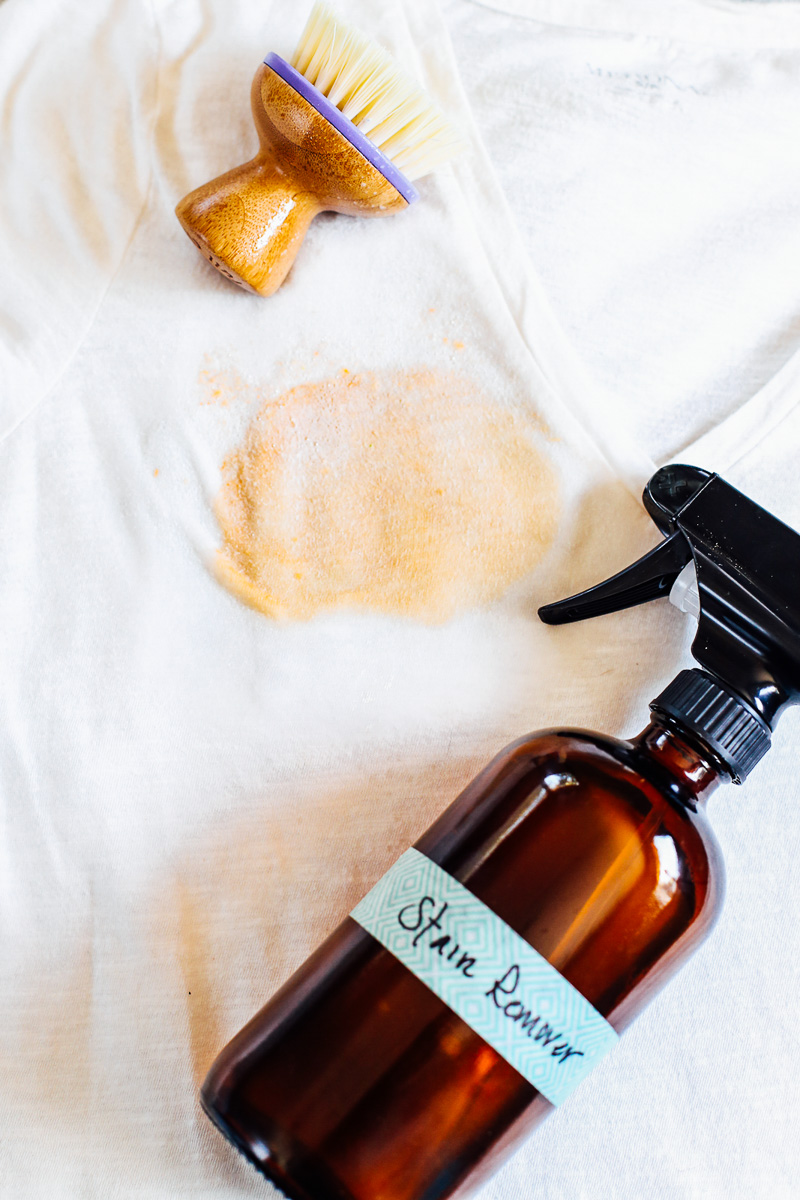
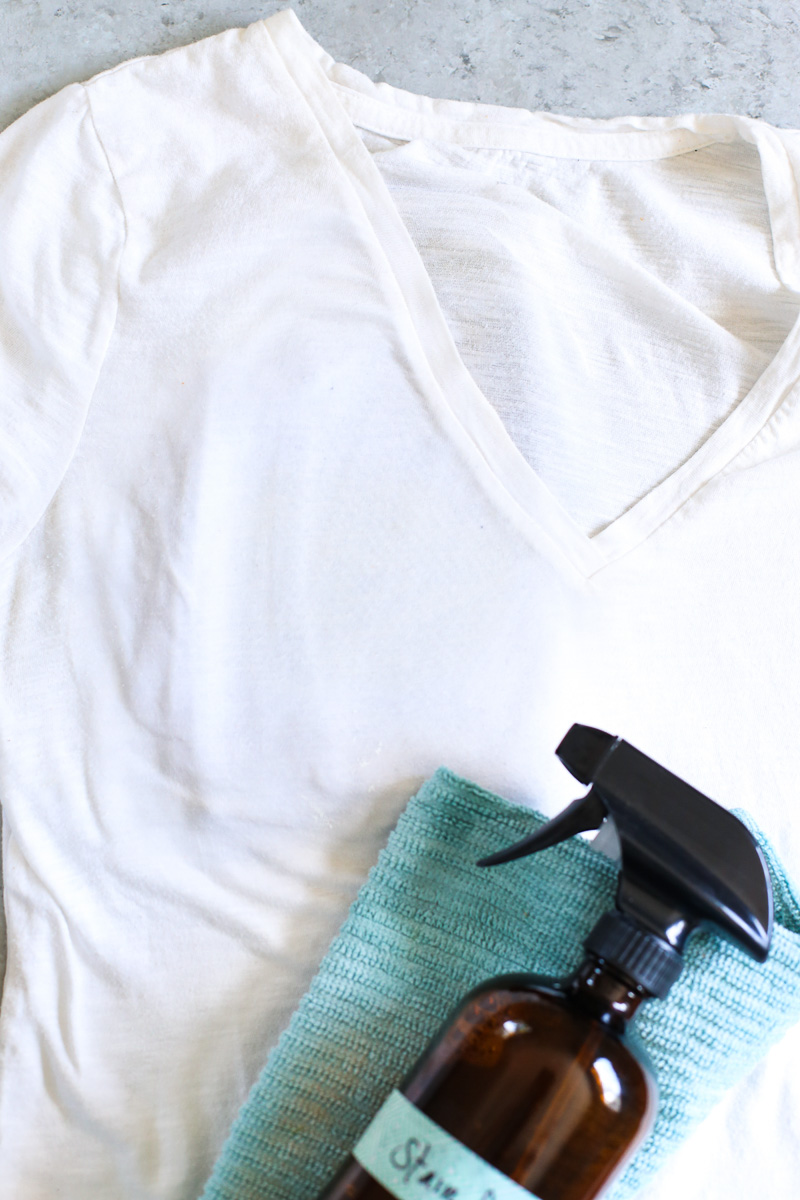
Key Takeaways
- You only need a few natural ingredients to make multiple bottles of stain remover spray: vegetable glycerin, water, liquid castile soap, hydrogen peroxide, and lemon essential oil. You can easily find these ingredients in the grocery store or online (like Amazon).
- Use this stain remover to remove many different stains on fabrics (including sofas, carpets, and clothing): food stains, pet stains, grass stains, baby stains, and more.
- Store this recipe in a dark amber bottle for up to 1 month in the laundry room.
Before You Get Started: What You’ll Need
First, gather the ingredients you’ll need. You’ll find these ingredients at most grocery stores or on Amazon.
- 1/4 cup vegetable glycerin: helps to lift stains easily; however, if you don’t have any glycerin you can skip this ingredient.
- 1/4 cup water: Use distilled water if storing this product longer than a few days.
- 1/4 cup liquid castile soap: a natural, highly-concentrated soap with many uses. A natural dish detergent or Dawn dish soap may be used instead.
- 1 TB hydrogen peroxide: Regular 3% strength found in the grocery store.
- 40 drops of lemon essential oil: Since fresh lemon juice would spoil quickly, use lemon essential oil. Instead, you may use 1-2 juiced lemons if the spray is used within a couple of days. Learn more about using essential oils.
Equipment You’ll Need
- 1 dark amber spray bottle: Due to the hydrogen peroxide, which can’t be exposed to light when stored, use a dark spray bottle. If you’re making a small batch of this recipe and plan to use it immediately, it’s OK to use a clear spray bottle (or make your own glass spray bottle)
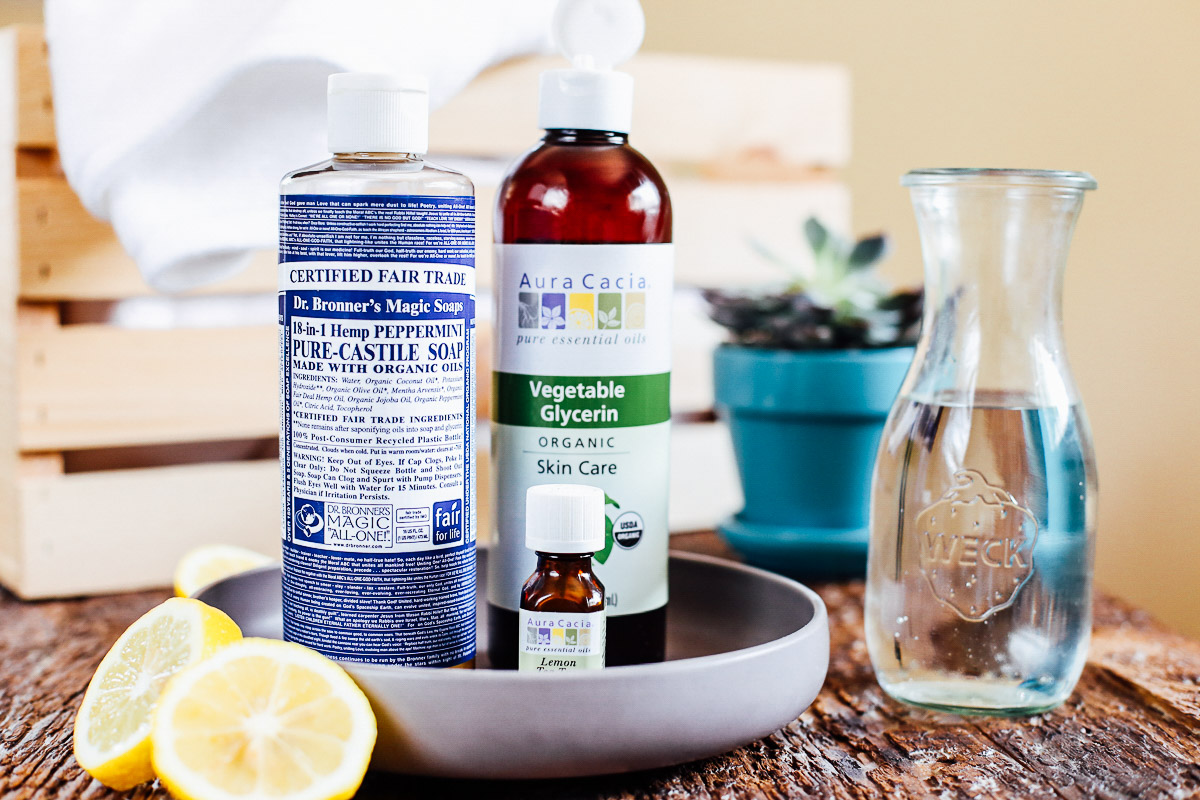
How to Make DIY Stain Remover: Step By Step Guide
You’ll also find a printable recipe card at the bottom of this post, so you can print and save the recipe.
- Step 1 Combine All Ingredients: In a spray bottle, add all the ingredients: glycerin, water, soap, hydrogen peroxide, and lemon essential oil. Place the lid on the bottle and shake to combine.
- Step 2 Use Immeadiately or Store For Later: The spray may be used immeadiately. It may also be stored for later use, at room temperature, in a dark location (like a dark cupboard under the sink or in the laundry room).
Step By Step Recipe Video Guide
How to Use This Spray & Remove Stains
- First, blot a liquid stain with paper towels or a cloth.
- Gently shake the DIY laundry stain remover spray. Spray or pour the solution on the stain (preferably a fresh stain).
- Let the stain remover rest for 5 minutes.
- Scrub the soaked stain with a scrub brush, old toothbrush, or cloth until the stain has been lifted. Repeat again, if needed, until the stain lifts.
- Rinse the garment in hot water with soap or in the washing machine using your favorite laundry soap.
- For a stubborn stain, after using the spray, place the garment in the washing machine with ½ cup washing soda and ½ cup hydrogen peroxide, along with whatever laundry soap you normally use in your laundry routine.
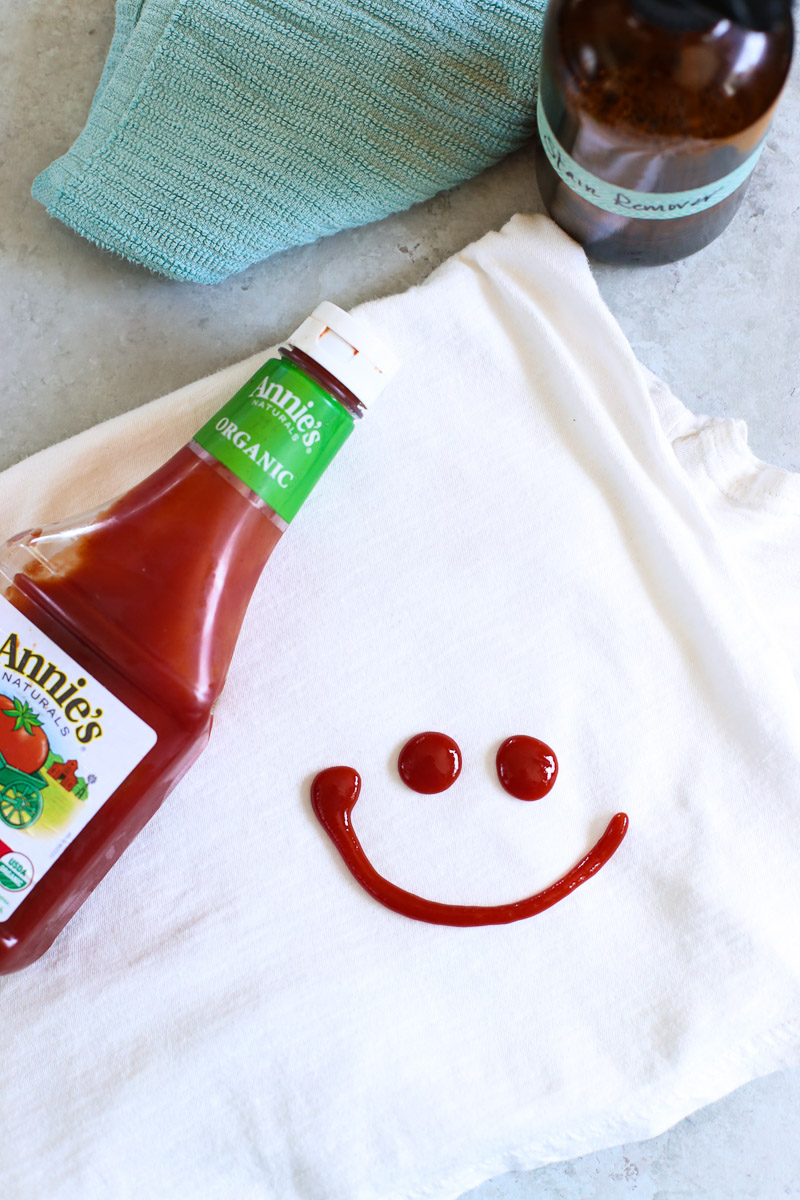
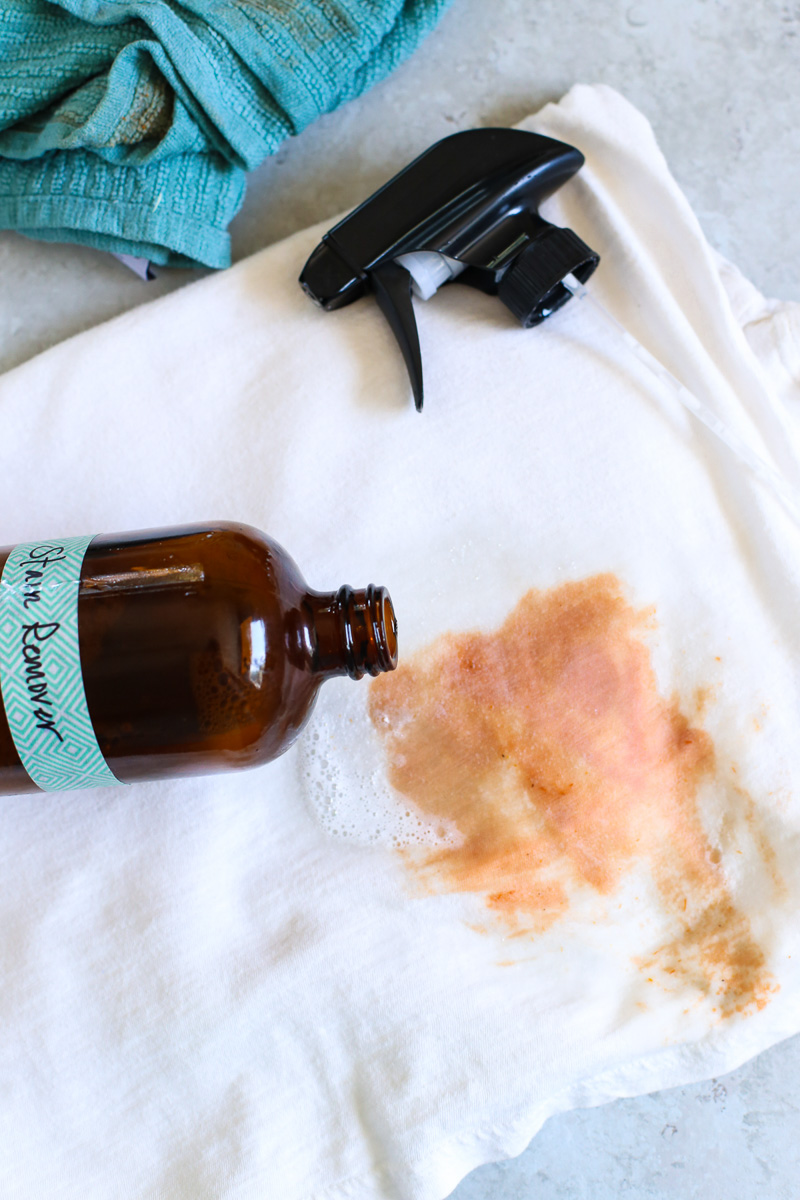
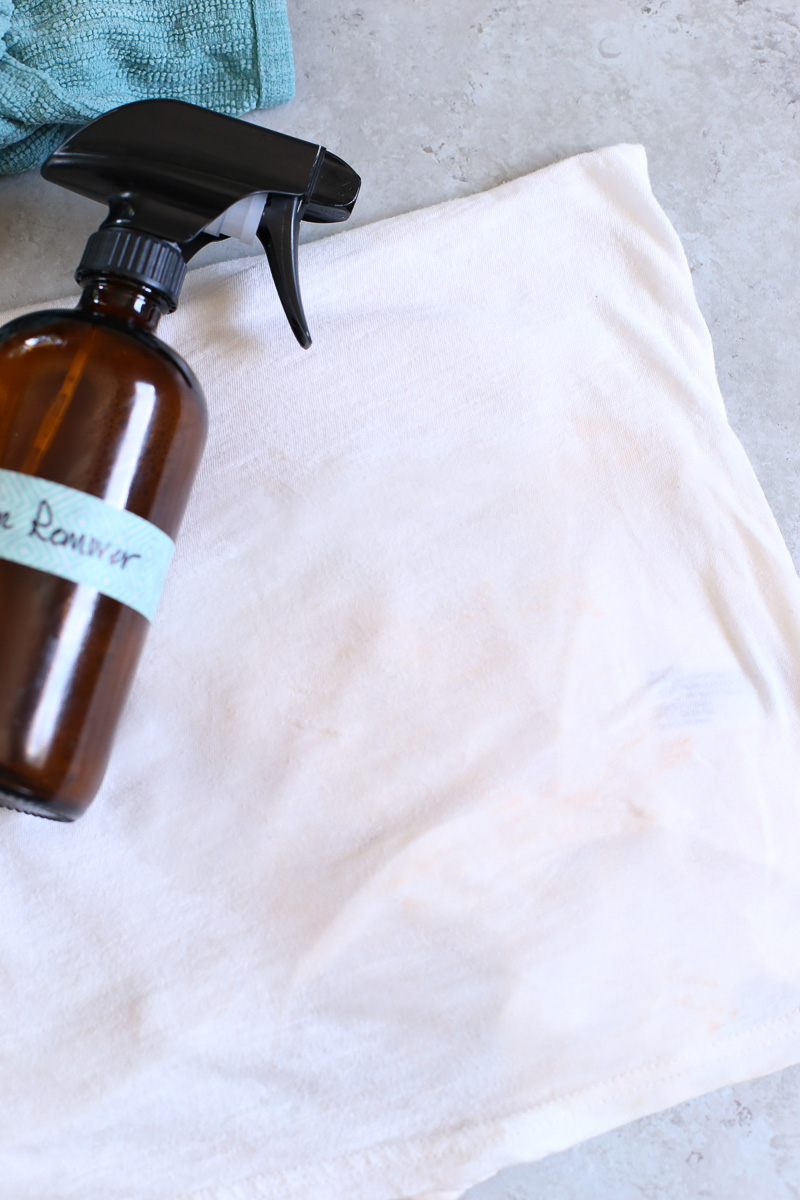
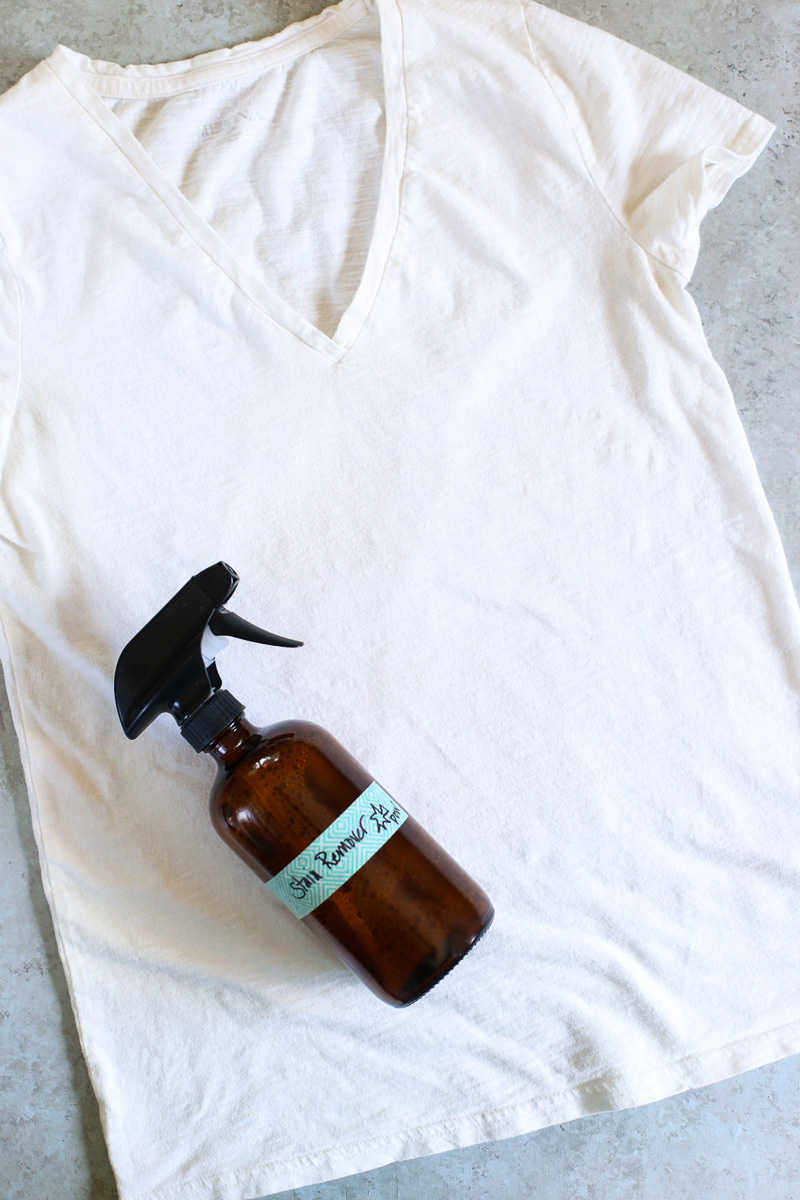
What kind of stains can you remove with this spray?
Here are just a few of the stains and surfaces I’ve personally used this easy homemade stain remover on.
- Carpets: Please test this spray first in a small area to ensure the hydrogen peroxide doesn’t discolor your carpet.
- Couches: Dustin once spilled red wine on my prized white couch. This stain remover was my first defense, then I used my homemade bleach alternative to finish the job.
- Clothes: Remove any food, pen marks, blood stains, or grass stains with this solution.
- Pet Stains: Remove Fido’s waste from the surface, spray with the solution, allow time to rest, then wipe the area with fresh water and a cloth.
- Pen and Marker Stains: If you have kids, you know what I’m talking about!
- Food Stains: Chocolate stains, coffee stains, red wine stains, ketchup stains, mustard stains–this solution lifts and dissolves them all.
- Baby Stains
- Fresh Grease Stains: I also like using this grease removal method.
What to Avoid Doing
- Only apply the stain remover to special garments or fabrics after testing first. Anytime you use a cleaning product, always spot-test in an inconspicuous area.
- Don’t store the spray in a clear bottle, which exposes the formula to direct sunlight due to the fragility of the hydrogen peroxide.
FAQs
- Can you use this stain remover on colored fabrics? From my experience, this solution is safe on colors. Always test a small area before applying the solution to a larger fabric surface.
- Can you use dish soap instead of castile soap? Yes, you can! You can use any dish detergent, including Dawn Dish Soap or a natural dish soap.
- Can I use a plastic spray bottle instead of glass? Yes, you can. Make sure the bottle doesn’t let light through (such as a clear bottle) due to the hydrogen peroxide.
Looking For Natural Laundry Detergent, too? Try These Products
After using the stain remover, wash the garment in a natural laundry detergent. There are many great options. Here are my favorites:
- Homemade Liquid Laundry Detergent: Use water, castile soap, borax, and washing soda to make this easy liquid soap.
- Powder Laundry Soap: Use castile soap bars, borax, and washing soda to make a powder soap option.
- The Best Natural Laundry Detergents From the Store: From Seventh Generation to Ecos, I share the best of the best laundry detergents from the grocery store.
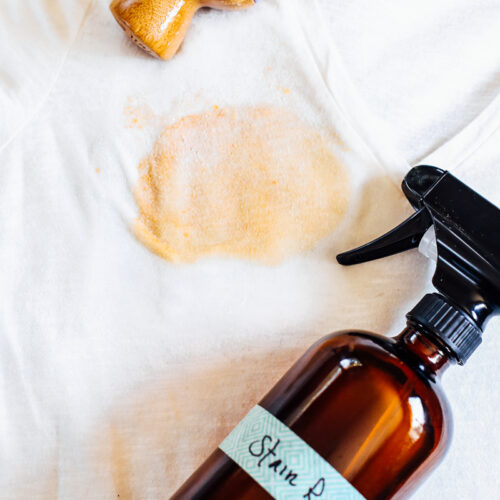
Natural Homemade Stain Remover Recipe
Equipment
- 1 16-ounce dark spray bottle or 8-ounce spray bottle
Ingredients
- 1/4 cup vegetable glycerin a natural solvent that lifts stains
- 1/4 cup distilled water or tap water if using within a couple of days
- 1/4 cup liquid castile soap unscented or any variety
- 1 TB hydrogen peroxide 3% strength
- 40 drops lemon essential oil or fresh lemon juice (from 1-2 lemons) if using within 1-2 days
Instructions
- In a dark spray bottle (due to the hydrogen peroxide which can't be exposed to light during storage), add all the ingredients.
- Place the lid on the bottle. Gently shake the bottle to combine the ingredients. Shake before each use.
- How to Use (Lift and Remove Stains):
- First, blot a liquid stain with paper towels or a cloth.
- Gently shake the bottle. Spray or pour the solution on the stain (preferably a fresh stain).
- Let the stain remover rest for 5 minutes.
- Scrub the soaked stain with a scrub brush, old toothbrush, or cloth until the stain has been lifted. Repeat again, if needed, until the stain lifts.
- Rinse the garment in hot water with soap or in the washing machine using your favorite laundry soap.
- For a stubborn stain, after using the spray, place the garment in the washing machine with ½ cup washing soda and ½ cup hydrogen peroxide, along with whatever laundry soap you normally use in your laundry routine.
Video
Notes
Free RECIPE Cheatsheet
8 Natural Recipes for Your Laundry Room
More Easy Stain Remover Options
The good news is my homemade stain remover spray will conquer just about any stain!
I also want to provide you with a guide for how to use natural household ingredients to tackle stains. Different types of stains require different types of solutions.
There are 8 simple ingredients that work best for natural stain removal, no matter what kind of stain you need to conquer. Here are the best options that can easily be found at most grocery stores.
- SOAP – Liquid castile soap or Sal Suds are fantastic for removing grease stains.
- BAKING SODA – Remove any oily stain, rust stains, crayon on surfaces, permanent marker on surfaces, and freshening the laundry. For rust stains and cleaning, combine baking soda, hydrogen peroxide, and castile soap (scrub recipe). How to use baking soda for stain removal and cleaning.
- LEMONS – Apply lemon juice to a garment to remove yellow underarm stains on white clothes. And remove rust stains on surfaces.
- WHITE VINEGAR – Remove mildew stains with vinegar. And remove yellow underarm stains: spray a garment with vinegar, rest, then scrub and wash with laundry soap.
- BORAX – Borax is a naturally-occurring mineral and safe for the environment. Used to make liquid homemade laundry soap and powdered laundry soap to boost the soap’s effectiveness and fight against stains. Make homemade bleach alternative using Borax and Washing Soda.
- TABLE SALT – Used to soften hard water (homemade laundry softener with salt) and lift red wine stains. Immeadiately after a wine spill, sprinkle the surface with salt. Allow time for the salt to absorb the wine, then brush the salt off and wash the garment with laundry soap.
- CORN STARCH – Absorbs grease and oil stains. Immeadiately after an oil stain occurs, sprinkle the garment with corn starch and rub the area. Allow the starch to rest for 10 minutes, then wash the garment with laundry soap. Do NOT dry until the oil stain is fully removed.
- VEGETABLE GLYCERIN – A natural solvent, glycerin works to easily lift stains from garments.

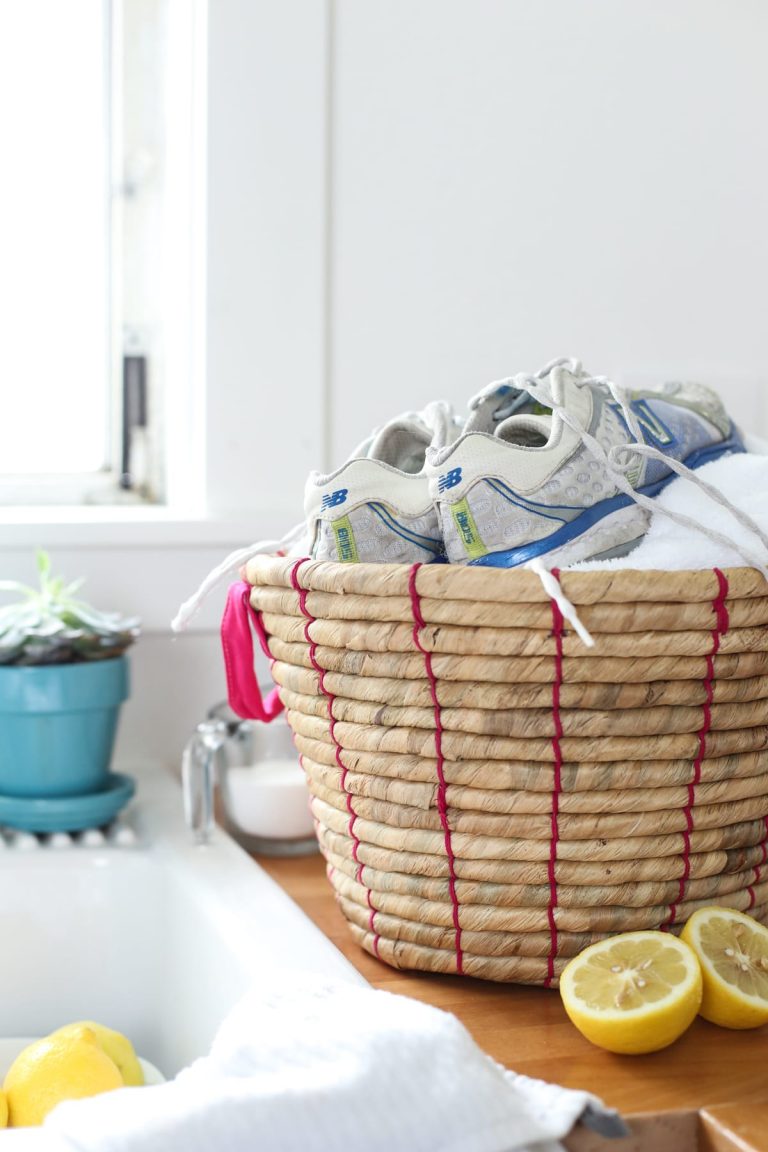
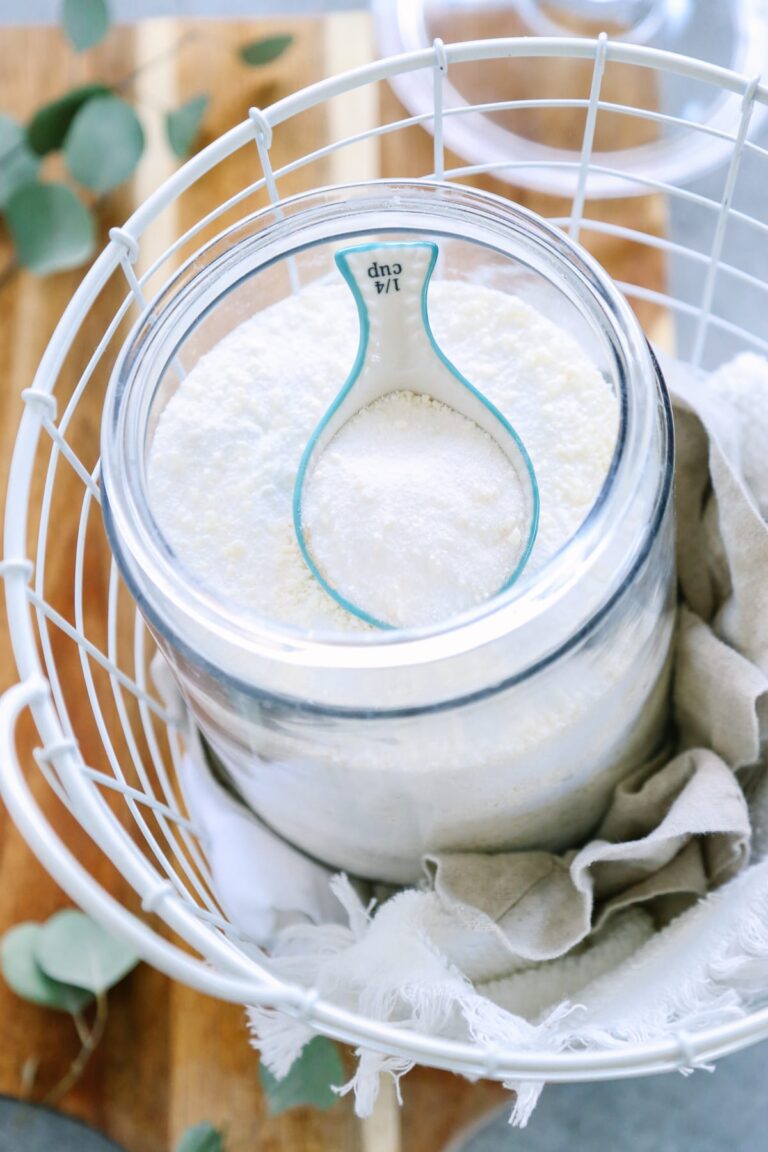
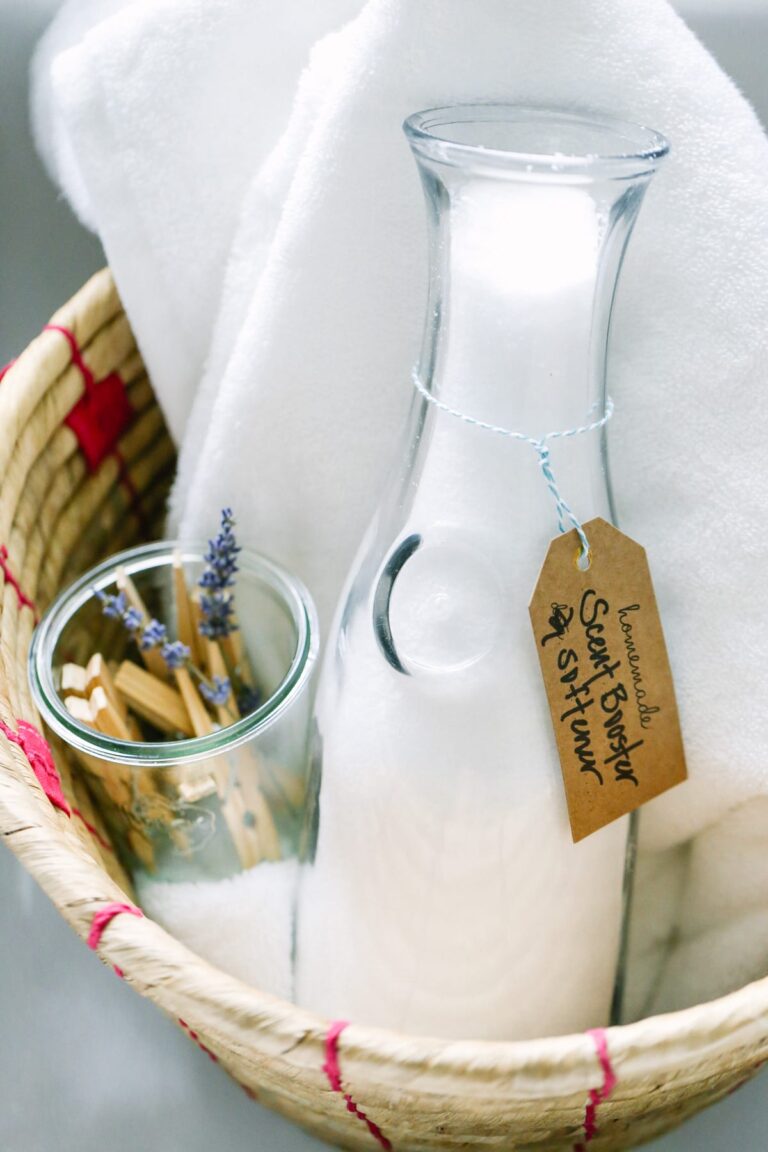

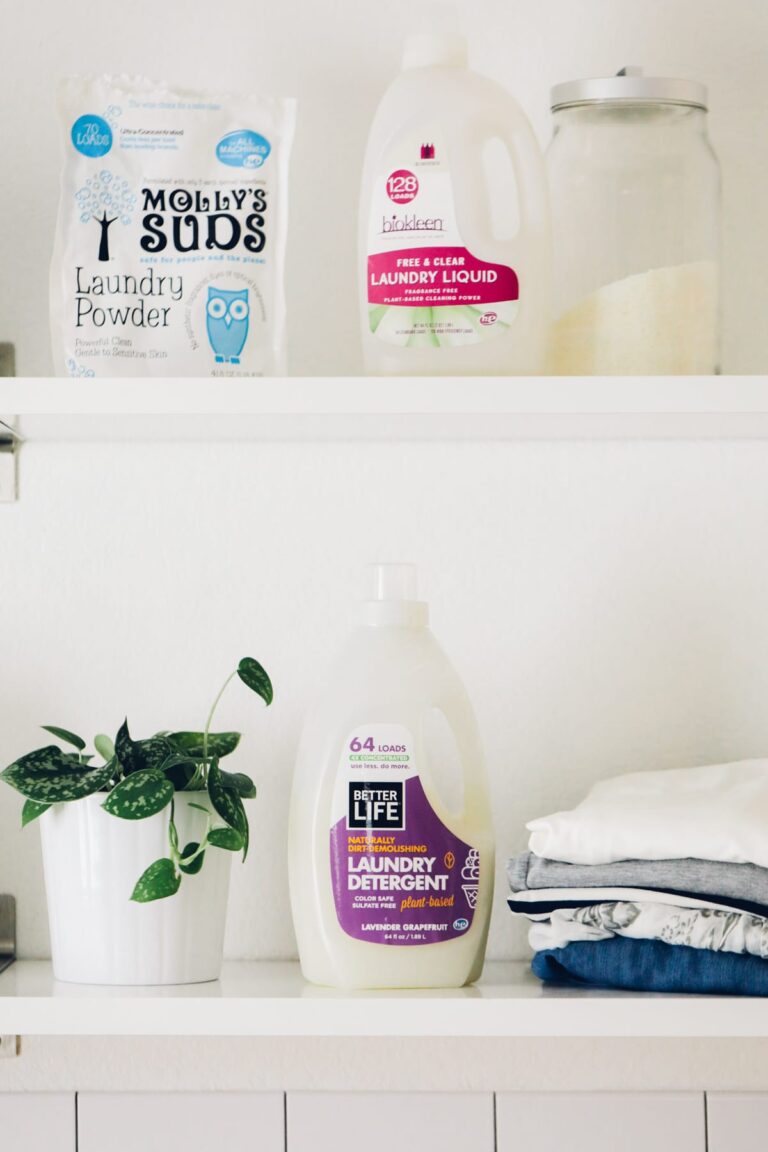
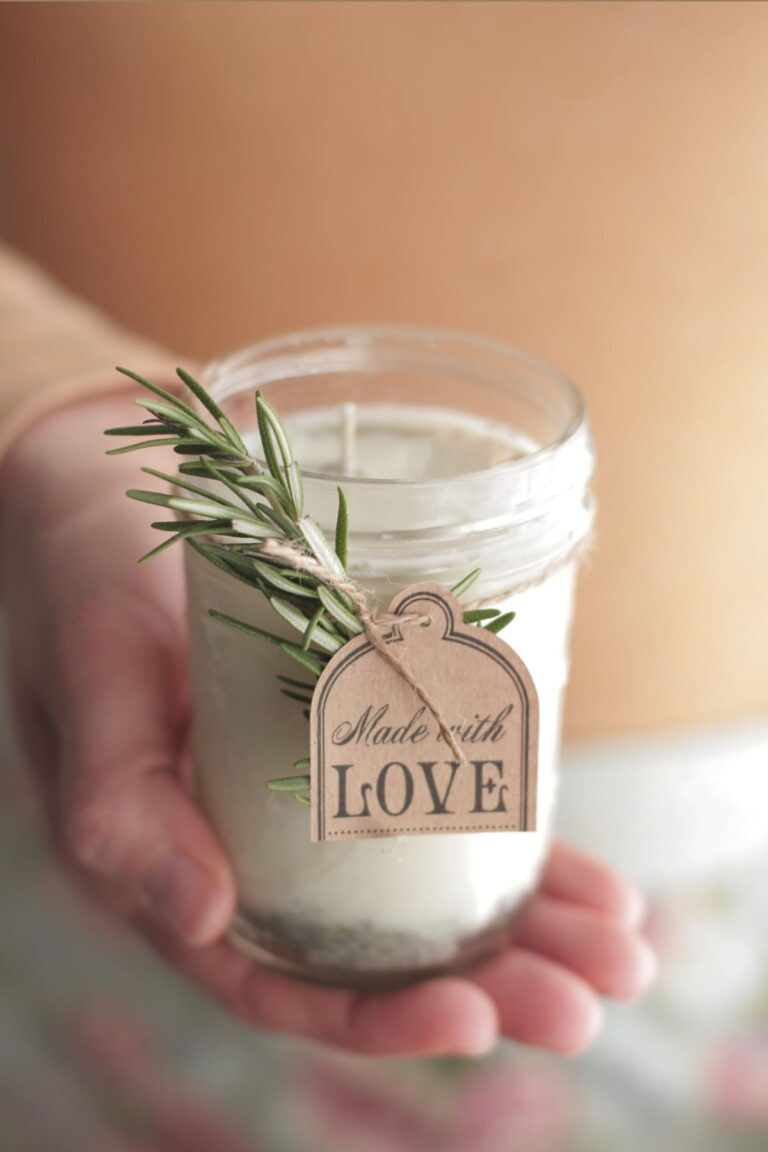
Hello, I really like the stain remover and although I have it in a taped up bottle (so it won’t let in the light) it starts to have a funny smell after a couple of weeks. Is that the peroxide? or does it just have a really short shelf life? I used boiled and cooled water and lemon essential oil. Thanks!
Hi Amanda, Kristin is travelling outside the country at this time, but I will make a note of your comment for her so she can respond when she returns. ~Rachel
Thanks! I have since also tried it in a spray bottle like the one pictured and after one week smells bad again. Thanks, Amanda
Hey Amanda, It may be the hydrogen peroxide changing. The product does have a shorter lifespan than other sprays, due to that ingredient. You may want to reduce the amounts and just mix up a small amount.
Can I use regular castile soap of does it have to be peppermint, tee tea or orange?
Hey Michelle, Any scent will work!
Hi,
I am hoping you might have some help for me. We have a 9 month old and I am having so much difficulty getting the stains out of his clothes! I have tried your stain remover as suggested with the washing soda and peroxide in the wash to no avail, soda and peroxide soak, even soaking in tropical traditions all purpose cleaner overnight and they still remain. Its red/ purple/orange colors that are most problematic. Any suggestions?
Hey Lauren, I would love to help you troubleshoot! By chance, do you know what is causing the stains? Knowing the source of the stains can help with knowing how to tackle them.
Good post, Kristin. Thank you. I love it when I already have all the ingredients 🙂
The “Find my favorite DIY ingredients and tools, here.” link says: Ooops! That page can not be found.
Have a great day,
Carrie
Hey Carrie, Thanks so much! Oh no, I’ll have my tech guy fix it ASAP. Thanks for letting me know!
This works so well! I put it in a clear glass spray bottle because I didn’t have a dark one. I’ve been storing it in the dark, but do you know how quickly the hydrogen peroxide breaks down when exposed to light? Should I get a dark bottle or tape something to the clear bottle?
Hey Kate, I”m so glad you’re enjoying the stain remover. It will break down very quickly–I believe within a few hours. I would either tape the bottle, or purchase a dark bottle from the future.
Hi Kristin, looking forward to trying this solution. Does the 1/3 ounce Plant Therapy Essential Oil bottle give you the 40 drops your “recipe” calls for?
40 drops of essential oil is almost half of a 5 ml bottle so Kristin’s bottle would contain enough.
This recipie solidified and did not work. Waste of time and money. 1/4 cup of water? Can’t believe I spent so much time ordering veg glycerin etc. Every time I add mor water and shake it up it solidifies and won’t spray. Super annoying post has been up for a year and no mention of this. Did u even make this?
Hey Tessa, I’m not sure why this is happening to your spray. I can’t imagine why the ingredients would be solidifying since there’s nothing that would solidify. Were you able to use this right after making it? Or was the issue as the spray sat in storage? Which glycerin and spray bottle did you use? It sounds like maybe the glycerin was really thick, or the spray nozzle on the bottle isn’t working for this solution. For now, you could apply this directly on the stain, pouring it on versus spraying. The goal is to get rid of the stain, and this solution should do it :).
I use this regularly on stains, and many readers use this, too, so I would love to help you figure out what’s going wrong. Every single recipe on the blog is tested and used in my own home–and the pictures in this post are real :). This issue hasn’t been addressed in the post, because I’ve never heard of or seen the spray solidify. I personally don’t gain anything from posting something that would be a failure. Feel free to email me with photos, and I’d love to help you figure out what’s happening! Seeing a visual is really helpful for trouble-shooting DIYs.
Email: [email protected]
Did she use gelatin instead of glycerin?
Hey Am, I didn’t even think of that, but that would be the best explanation based on what’s happening. Good thought.
Hi Susie Was wondering what is the alternative to castile soap, could I use any soap?
Hey Ummali, You may be able to use a more natural dish soap.
Do you have a recipe for removing grease stains from clothing?
Hey Susie, I apply castile soap or Sal Suds (Sal Suds really works best) directly on the grease stain, and then scrub it with the soap. Let it sit for about 15-30 minutes, and then wash the garment. Repeat this step before drying until the grease is gone. This works with fresh grease stains. Once the garment is dried in the dryer, it’s really hard to remove a grease stain.
Curious about using lemon eo on my babies clothes? I already use hydrogen peroxide mixed with Palmolive dish soap and water on his poppy clothes but want to switch to chemical free. (No dish soap) but I’m worried about the essential oil.
Hey Danielle,
I don’t think the lemon essential oil will be an issue, particularly because you’ll need to wash the garment after using the stain remover. While this list from The Hippy Homemaker is meant for topical and diffusion purposes, versus a washable stain remover, it’s really handy to bookmark: http://www.thehippyhomemaker.com/essential-oil-safety-babies-children/. You may even be able to get by without the essential oil, and just use the other ingredients in the stain remover spray.
Lemon essential oil is cold pressed from the rinds so it does not contain the acidic juice. It should be safe to use on your baby’s clothing and non-irritating to skin.
I was wondering if this could be used on colors? Just making sure it wouldn’t remove the color to!
Hey Grace, I’ve used this on some colors (lighter colors, not blacks) and so far the spray hasn’t removed the color. Every color/garment is probably different, so I would try testing a small area first.
Do you know about how big your spray bottle is? I have a really small dark colored one, but I’m wondering if I should cut the recipe in half or buy a new bottle or something depending on how much the recipe creates 🙂 Thanks!
Hey Natalie, I use a 16 oz. spray bottle (http://amzn.to/1NHXB5g), but the stain remover spray only takes up about 1/3-1/2 of the bottle. A smaller bottle will definitely work!
First of all, I absolutely love your blog, the attention to detail and effort that goes into your posts and pictures, wow!
I followed this stain remover recipe down to the T, we had a big spill on our fabric beige-coloured sofa and I sprayed some of this on and now it’s badly stained, I think from the glycerin because it’s sticky! Wondering if this works only if you wash the item afterwards? Not to spray and leave on?
Hey Baan, Oh no! Is the sofa made with a special fabric? We have a cotton cream couch that I use this on a lot, but I also rinse the fabric with a bit of water after the stain remover has been sitting for a few minutes, similar to clothes and the washing machine. I recommend using plain water to wash the stain remover off, that should remove any residue that may have been leftover from the spray.
I’m so glad you enjoy the blog :)!
Have you used this without the peroxide? If so did it work? I am just worried about my colored clothes bleaching.
Hey Sharon, I haven’t. You could try it without the peroxide, and easily add it in if the other ingredients aren’t getting the job done.
Hi Kristin, can you tell me what the TBS of peroxide does? I wondered about that with your tub cleaner as well which, by the way, still brings me joy every time I use it. I have tendonitis & cannot really scrub much so before, I used to Tilex but the fumes were truly horrible. Still makes me gasp to think about it.
Hey Carolyn, I’m so glad you love the tub cleaner :). The hydrogen is a natural bleaching/whitening agent. In fact, store-bought bleach alternatives are made of hydrogen peroxide! So the hydrogen provides just enough “bleaching” without actually turning the clothes white–unless you pour hydrogen peroxide directly on the clothes. It’s used in a pretty small ratio here compared to the other liquid ingredients.
Had no clue it was that powerful at small amounts – thanks a bunch!
Hi, Kristin!
I was wondering … What does the glycerin do? And is there a difference between glycerin and vegetable glycerin?
Thanks!
Hey Madeline, Glycerin(e) is a natural solvent, making it a secret “weapon” for fighting stains. Vegetable glycerin(e) is the same as glycerin :).
Thank you Kristin, you save my boy’s white shirts! I don’t know how many shirts i threw out! Love reading your blog so so much.
Thank you so much, Katie! I’m so glad you love reading the blog. Enjoy the white shirts again ;).
Thanks for posting this – it’s one of the few products I still buy that is packaged in plastic. I have a vacation rental business, and our sheets and towels need to look brand new for every guest, so this one is important to me! I wonder about using citric acid rather than lemons? Any thoughts on it? It seems stable and it could be an extra boost even with the essential oil.
Hey IthacaNancy, I’m not sure about citric acid. It may work? Maybe a combo of citric acid and lemon essential oil? If you try it let me know if the combo works.
Just want to make sure…I can only use this on whites?
Thanks you for the recipe!
Hey Sandy, I use this on colors, too. The only concern for whitening is the use of hydrogen peroxide, so this could be left out :).
You put a smile on my face with this post. I didn’t know if I should be humming the theme song from Wonder Woman or Batman. Pow! Bang! Wow!
Happy weekend to you!
Lol, JoAnn! That’s awesome. Now I’m singing the Batman song!